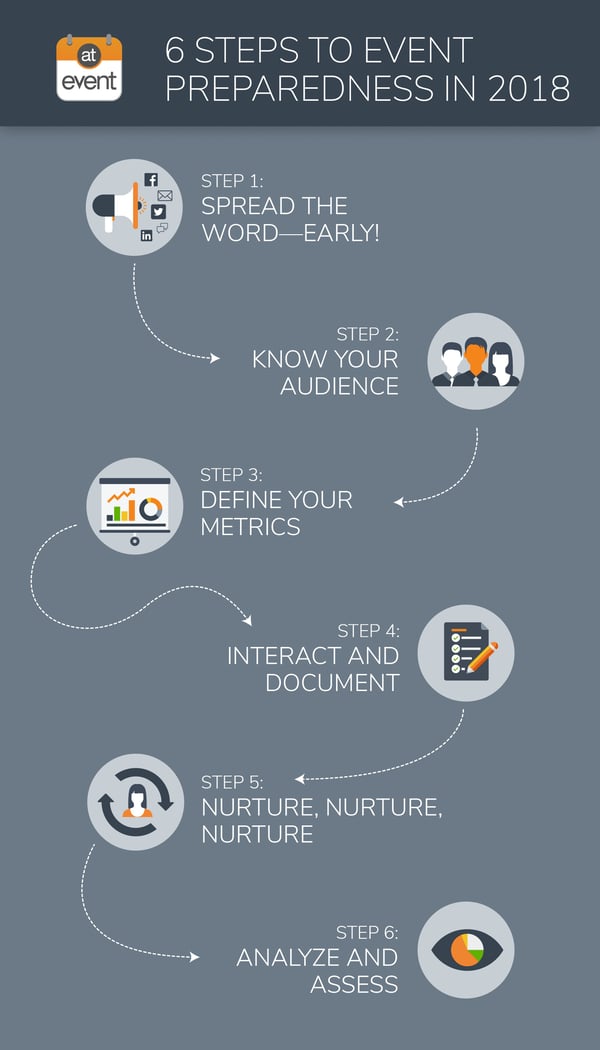They say the Big One could hit any day. Maybe next year, next month, or even next weekend. Are you prepared?
No, we aren’t talking about a natural disaster (though you may sometimes feel like you’re in constant disaster prevention mode); we’re talking about your next big event. You pour so much blood, sweat, and tears—not to mention money—into your events; we want to make sure you come home from your next one with more to show for it than ever. In this post we’ll show you how to prepare so you can survive the inevitable landslide of questions around ROI, and prove your event was a success.
Step 1: Spread the Word—Early!
If your marketing and sales teams aren’t already working in tandem, now’s the time they need to start coordinating their event prep efforts. As you approach the 4-6 week mark before an event, your marketing team should be trying to amp up engagement with people who are already aware of your solution, and drive these prospects to meet with your sales team at the event. One approach is to run an email and re-targeting display ad campaign that directs prospects to set up an appointment.
Step 2: Know Your Audience
While your pre-event inbound marketing campaign may have generated some appointments, your sales team shouldn’t stop there. Tech is the name of the game in 2018, which means you have a host of intelligence gathering tools at your fingertips. Check attendee and sponsor lists to find out who will be there. Then, using your event management, marketing automation, or CRM system, brush up on both the prospect’s and account’s recent history with your company. What kind of content are they consuming? Are they asking for a demo? Do your research, and then, reach out directly to important prospects who have not yet answered the call for appointments.
Step 3: Define Your Metrics
The next step is to define how you’re going to determine whether the event was a hit or a flop. Gone are the days of counting business cards in the fishbowl to determine event ROI. If you’re still focused on quantity, not quality, it’s time to shift your focus. Here are some possible metrics to track:
- What percentage of your covered accounts were engaged?
- How many new accounts were added for nurture?
- How many marketing qualified leads (MQLs) were generated?
- How many sales qualified leads (SQLs) were generated?
- What was your sales velocity after the event?
Once you’ve defined your success criteria, plan your event strategy accordingly. For example, if one of your metrics is the number of new accounts added for nurture, how have you prepared your sales team to work toward this goal? Tying event planning, management, and execution strategies to your predetermined metrics is critical to event success.
Step 4: Interact and Document
You want to go beyond just drawing curious prospects to your booth; you want to have quality interactions that help you gain insight into prospects’ readiness to buy. How you document those interactions may mean the difference between a sale and a missed opportunity. The best way to do this is with an app that allows booth staff to quickly capture accurate contact information and add important context about the interaction. We may be biased, but we think atEvent does this pretty darn well; it lets you note prospects’ topics of interest, requested follow-up actions, and more, so you can automatically segment and score event leads for more timely follow-up, and then integrates everything automatically with your CRM/MA system.
Step 5: Nurture, Nurture, Nurture
Now that you've got your leads, it's time to prioritize your follow up. Route your hot leads to the right salesperson. This salesperson should be able to use the interaction notes to continue the conversation from the event. For leads that need some more time, place them in the right nurture stream, which should also be a continuation of that first conversation. And for those prospects who came for that cool giveaway but don't fit your target market, you'll want to note that sales should not waste precious time and resources chasing them down.
Step 6: Analyze and Assess
Drum roll … Now’s the time to see how the event measured up against those metrics you set up before the event. Some event lead management solutions, such as atEvent, provide easily accessible event intelligence and reports that will make measurement a snap. Whatever system you use, what you measure should relate directly back to the metrics you defined in Step 2 of this process. This will allow marketing and event planners to adjust the strategy for your next event to better meet the needs of attendees.
When it comes to surviving the constant push for more event ROI, it’s all about preparing, documenting, and following through. Follow these steps, and you’ll be proving positive event ROI when the next Big One hits.









